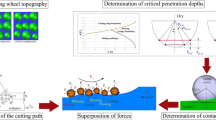Abstract
In this study, we propose a new approach to investigate the influence of the grinding process parameters on the friction coefficient of the ground surface when in contact with another surface. This is achieved through the implementation of a physics-based model capable of predicting the friction coefficient. The model is based on hydrodynamic lubrication theory, solving a special case of the Navier-Stokes equations (Reynolds equation). The model will provide more insights to help optimize the grinding parameters and therefore surface texture, thus achieving the desired product functionality in term of tribological behavior. The model is being validated using reported experimental data. A case study on the influence of grinding wheel speed on the surface roughness and tribological behavior is performed. Based on the predicted results, we report an average friction coefficient in the transverse direction lower than the longitudinal. The proposed predictive approach demonstrates capacity in predicting the impact of grinding wheel speed on the friction coefficient, hydrostatic pressure, and average film thickness for a defined contact condition, hence more insights on the tribological functionality of a ground surface.
Similar content being viewed by others
References
Benardos PG, Vosniakos G-C (2003) Predicting surface roughness in machining: a review. Int J Mach Tools Manuf 43:833–844. doi:10.1016/S0890-6955(03)00059-2
Fergani O, Liang SY (2015) The effect of machining process thermo-mechanical loading on workpiece average grain size. Int J Adv Manuf Technol 80:21–29. doi:10.1007/s00170-015-6975-8
Warren AW, Guo YB (2009) Characteristics of residual stress profiles in hard turned versus ground surfaces with and without a white layer. ASME. J Manuf Sci Eng 131(4):041004–041010. doi:10.1115/1.3159046
Jawahir IS, Brinksmeier E, M’Saoubi R, Aspinwall DK, Outeiro JC, Meyer D et al (2011) Surface integrity in material removal processes: recent advances. CIRP Ann - Manuf Technol 60:603–626. doi:10.1016/j.cirp.2011.05.002
Shao Y, Fergani O, Li B, Liang SY (2015) Residual stress modeling in minimum quantity lubrication grinding. Int J Adv Manuf Technol 83:743–751. doi:10.1007/s00170-015-7527-y
Shao Y, Fergani O, Ding Z, Li B, Liang SY (2015) Experimental investigation of residual stress in minimum quantity lubrication grinding of AISI 1018 steel. ASME. J Manuf Sci Eng 138(1):011009–011007. doi:10.1115/1.4029956
Li B, Ding Z, Xiao J, Liang SY (2016) Maraging steel 3J33 phase transformation during micro-grinding. Mater Lett 164:217–220. doi:10.1016/j.matlet.2015.10.162
Tomanik E (2008) Friction and wear bench tests of different engine liner surface finishes. Tribol Int 41:1032–1038. doi:10.1016/j.triboint.2007.11.019
Grabon W, Pawlus P, Sep J (2010) Tribological characteristics of one-process and two-process cylinder liner honed surfaces under reciprocating sliding conditions. Tribol Int 43:1882–1892. doi:10.1016/j.triboint.2010.02.003
Demirci I, Mezghani S, Yousfi M, Zahouani H, El Mansori M (2012) The scale effect of roughness on hydrodynamic contact friction. Tribol Trans 55:705–712. doi:10.1080/10402004.2012.694990
M Yousfi, S Mezghani, I Demirci, M El Mansori (2015) Smoothness and plateauness contributions to the running-in friction and wear of strati fi ed helical slide and plateau honed cylinder liners, 332–333: 1238–1247. doi:10.1016/j.wear.2014.11.011.
Mezghani S, Demirci I, Yousfi M, El Mansori M (2013) Running-in wear modeling of honed surface for combustion engine cylinderliners. Wear 302:1360–1369. doi:10.1016/j.wear.2013.01.026
Graziano AA, Ganguly V, Schmitz T, Yamaguchi H (2014) Control of lay on cobalt chromium alloy finished surfaces using magnetic abrasive finishing and its effect on wettability. ASME. J Manuf Sci Eng 136(3):031016–031018. doi:10.1115/1.4026935
Sabri L, Mezghani S, El Mansori M, Zahouani H (2011) Multiscale study of finish-honing process in mass production of cylinder liner. Wear 271:509–513. doi:10.1016/j.wear.2010.03.026
El Mansori M, Mezghani S, Sabri L, Zahouani H (2010) On concept of process signature in analysis of multistage surface formation. Surf Eng 26:216–223. doi:10.1179/174329409X455412
Yousfi M, Mezghani S, Demirci I, El Mansori M (2013) Study on the relevance of some of the description methods for plateau-honed surfaces. Surf Topogr Metrol Prop 2:014006:1–014006:7. doi:10.1088/2051-672X/2/1/014006
Decencière E, Jeulin D (2001) Morphological decomposition of the surface topography of an internal combustion engine cylinder to characterize wear. Wear 249:482–488. doi:10.1016/S0043-1648(01)00579-8
M Yousfi, S Mezghani, I Demirci, M El Mansori (2014) Comparative study between 2D and 3D characterization methods for cylinder liner plateau honed surfaces, in: Proc. NAMRI/SME, Vol. 42
Yousfi M, Mezghani S, Demirci I, El Mansori M (2016) Tribological performances of elliptic and circular texture patterns produced by innovative honing process. Tribol Int. doi:10.1016/j.triboint.2016.01.049
Rosen B-G, Anderberg C, Pawlus P, Thomas T (2009) Alternative descriptions of roughness for cylinder liner production. J Mater Process Technol 209:1936–1942. doi:10.1016/j.jmatprotec.2008.04.059
Rosen B-G, Anderberg C, Ohlsson R (2008) Parameter correlation study of cylinder liner roughness for production and quality control. Proc Inst Mech Eng Part B J Eng Manuf 222:1475–1487. doi:10.1243/09544054JEM1201
Pawlus P, Cieslak T, Mathia T (2009) The study of cylinder liner plateau honing process. J Mater Process Technol 209:6078–6086. doi:10.1016/j.jmatprotec.2009.04.025
AEH Love (1944) A treatise on the Mathematical Theory of Elasticity, 4th edition, dover, New York
Ehret P, Dowson D, Taylor CM (1998) On lubricant transport conditions in elastohydrodynamic conjunctions. Proc R Soc A Math Phys Eng Sci 454:763–787
Dowson D, Higginson GR (1966) http://books.google.fr/books/about/Elasto_hydrodynamic_lubrication.html?id=HuMuAAAAIAAJ&pgis=1 Elasto-hydrodynamic lubrication, the fundamentals of roller and gear lubrication. Pergamon Press, Oxford
Roelands CJA (1966) Correlational aspects of the viscosity-temperature-pressure relationship of lubricating oils. PhD thesis, Technical University Delft
Ren N, Zhu D, Chen WW, Liu Y, Wang QJ (2009) A three-dimensional deterministic model for rough surface line-contact EHL problems. J Tribol 131:011501:1–011501:9. doi:10.1115/1.2991291
Madanchi N, Winter M, Herrmann C (2015) Cutting fluid drag-out and exhaust air in grinding processes: influence on the eco-efficiency. Procedia CIRP 29:329–334. doi:10.1016/j.procir2015.02.054
Author information
Authors and Affiliations
Corresponding author
Rights and permissions
About this article
Cite this article
Fergani, O., Yousfi, M., Ding, Z. et al. A physics-based approach to relate grinding process parameters to tribological behavior of ground surfaces. Int J Adv Manuf Technol 91, 4151–4161 (2017). https://doi.org/10.1007/s00170-017-0111-x
Received:
Accepted:
Published:
Issue Date:
DOI: https://doi.org/10.1007/s00170-017-0111-x




